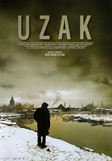
|
Distant The winner of the big prize at this year's Cannes festival, Distant is a tour-de-force of the possibilities of cinema. Throughout, director Nuri Ceylan conducts an ongoing conversation with the great defender of the iconic essence of film, Andrei Tarkovsky - with overt references to the Russian director, implicit stylistic choices, and even in-jokes. How appropriate that such a film be set in Istanbul, once Constantinople and Byzantium, the center of the controversy over icons in the Christian church, only to be conquered by the image-forbidding faith of Islam. I've always wanted to visit Istanbul, and never more so than after seeing this film. I'd always pictured the converted Byzantine-churches and Muslim minarets, but for some reason I never quite understood the central role of the sea in the identity of this city. Nor did I ever picture Turkey with snow, blizzard-like at times. The vistas of a dark-clad figure walking in the snow along the busy sea port with its ocean-going vessels are breathtaking, a must-see on a big screen. The story of Distant features - of course! - a photographer, who perhaps like the icon-maker Andrei Rublev in Tarkovsky's film, is failing to realize the full potential of his art. Unlike Rublev, he does not renounce the world in quest of artistic and spiritual truth, but lives comfortably, even luxuriously, in a society where the gap between haves and have nots is not just economic, but one of centuries. In a film so sensitive to the nature of the image, one notes the significance of words: the opening titles are white words on black, interspersed with beautiful images. The first spoken words we hear are recorded, on the answering machine Mahmut ignores. He has abstracted himself from the world, like words, is no longer engaged with either life or art. Yosuf, a have-not friend from his hometown shows up, looking for work, and a place to stay. What an odd couple they make! Mahmut is minutely in tune with his furniture and plumbing, but unable to engage with Yosuf on any but the most superficial level. This supposed lover of Tarkovksy uses images for commercial purposes, for isolated pleasures and for keeping others at bay. Meanwhile, director Nuri Bilge Ceylan, enages his teacher in-depth, but with a grasp of even more possibilities of cinema than the image-obsessed Russian. There are homages, sure, and long, long takes - including an interminable take of these two characters watching an interminable Tarkovsky take on television. One falls asleep and the other only pretends to be interested (in my experience, this is about the right ratio). But Ceylan doesn't just sculpt in time, to use the Russian's famous phrase, but also in space, and with narrative as well as cinematic elements, with sound as well as image. Ceylan manipulates depth-of-field, with exquisite control of focus, both in foreground and background. He does the same with light, in one incredible scene, changes the lighting in a hallway three or four different times by switching on and off different lights, maximizing the available textures. Likewise,
the director maximizes character blocking, choreographing placement and
movement with the camera movement. In this way, Ceylan controls the delivery
of information, visual and narrative, with carefully measured camera and
plot "reveals". Interestingly enough for a conversation on image,
the director uses audio in an almost Bressonian way - that is to say,
cranking up key sounds to enhance the picture, utilizing off-camera sounds
as well. The icon is intentionally simplified in order to make space for
the Divine presence; while perhaps not as simple and straightforward as
Tarkovsky might have made it, this masterful film explores the power and
dangers of the image in iconic fashion. But as with any icon, the experience
depends upon active participation.
|
